Troy-Bilt 2600 PSI User Manual
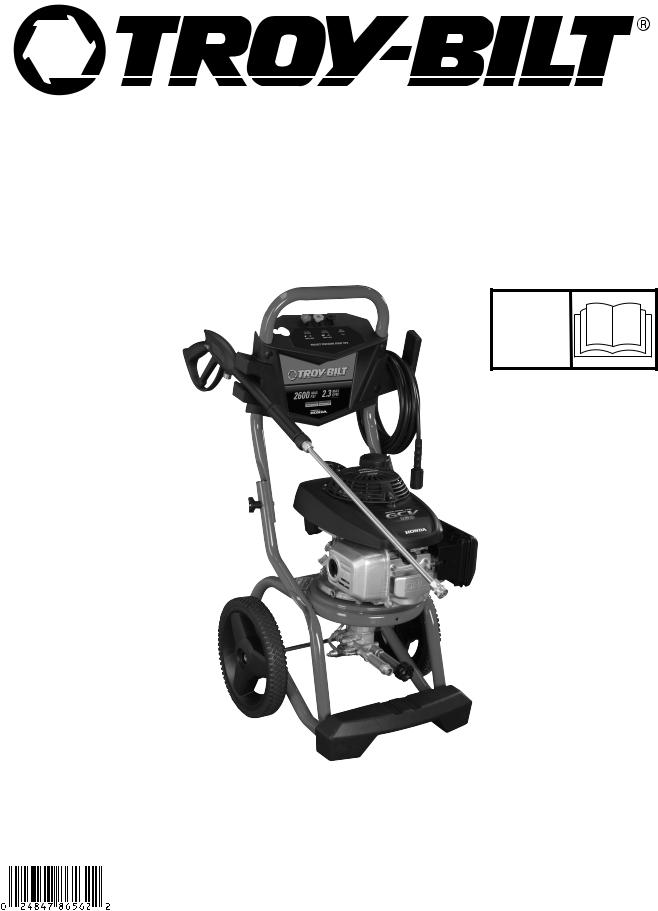
Pressure Washer
Operator’s Manual
This pressure washer is rated in accordance to the Pressure Washer Manufacturers Association (PWMA) standard PW101-2010 (Testing and Rating Performance of Pressure Washers).
BRIGGS & STRATTON POWER PRODUCTS GROUP, LLC
MILWAUKEE, WISCONSIN, U.S.A.
Manual No. 317313GS Revision -
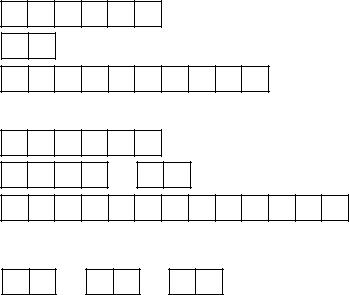
Thank you for purchasing this quality-built Troy-Bilt pressure washer. We are pleased that you’ve placed your confidence in the Troy-Bilt brand. When operated and maintained according to the instructions in this manual, your Troy-Bilt pressure washer will provide many years of dependable service.
This manual contains safety information to make you aware of the hazards and risks associated with pressure washers and how to avoid them. Because Troy-Bilt does not necessarily know all the applications this pressure washer could be used for, it is important that you read and understand these instructions thoroughly before attempting to start or operate this equipment.
Save these original instructions for future reference.
This pressure washer requires final assembly before use. Refer to the Assembly section of this manual for instructions on final assembly procedures. Follow the instructions completely.
Where to Find Us
You never have to look far to find Briggs & Stratton support and service for your pressure washer. Consult your Yellow Pages. There are over 30,000 Briggs & Stratton authorized service dealers worldwide who provide quality service. You can also contact Troy-Bilt Customer Service by phone at (888) 611-6708, or on the Internet at www.troybilt.com.
Pressure Washer
Model Number
Revision
Serial Number
Engine
Model Number
Type Number
Code Number
Date Purchased
Copyright © 2012. Briggs & Stratton Corporation
Milwaukee, WI, USA. All rights reserved.
TROY-BILT is a registered trademark of MTD.
Used under license.
2 |
www.troybilt.com |

Table of Contents
Operator Safety . . . . . . . . . . . . . . . . . . . . . . . . . . . . . . . . . 4
Equipment Description. . . . . . . . . . . . . . . . . . . . . . . . . . . . . . . . . . . . . . . . . 4
Important Safety Information. . . . . . . . . . . . . . . . . . . . . . . . . . . . . . . . . . . . 4
Assembly . . . . . . . . . . . . . . . . . . . . . . . . . . . . . . . . . . . . . 7
Unpack Pressure Washer. . . . . . . . . . . . . . . . . . . . . . . . . . . . . . . . . . . . . . . 7 Attach Handle and Accessory Tray . . . . . . . . . . . . . . . . . . . . . . . . . . . . . . . 7 Add Engine Oil and Fuel. . . . . . . . . . . . . . . . . . . . . . . . . . . . . . . . . . . . . . . . 8 Lubricate O-Rings . . . . . . . . . . . . . . . . . . . . . . . . . . . . . . . . . . . . . . . . . . . . 8 Connect Hose and Water Supply to Pump. . . . . . . . . . . . . . . . . . . . . . . . . . 9
Features and Controls . . . . . . . . . . . . . . . . . . . . . . . . . . . . 10
Operation . . . . . . . . . . . . . . . . . . . . . . . . . . . . . . . . . . . . 11
Pressure Washer Location. . . . . . . . . . . . . . . . . . . . . . . . . . . . . . . . . . . . . 11
How to Start Your Pressure Washer . . . . . . . . . . . . . . . . . . . . . . . . . . . . . 11
How to Stop Your Pressure Washer . . . . . . . . . . . . . . . . . . . . . . . . . . . . . 12 How to Use Accessory Tray. . . . . . . . . . . . . . . . . . . . . . . . . . . . . . . . . . . . 13 How to Use Spray Tips . . . . . . . . . . . . . . . . . . . . . . . . . . . . . . . . . . . . . . . 13 Applying Detergent . . . . . . . . . . . . . . . . . . . . . . . . . . . . . . . . . . . . . . . . . . 13 Pressure Washer Rinsing . . . . . . . . . . . . . . . . . . . . . . . . . . . . . . . . . . . . . 14 Cleaning Detergent Siphoning Tube. . . . . . . . . . . . . . . . . . . . . . . . . . . . . . 14 Automatic Cool Down System (Thermal Relief). . . . . . . . . . . . . . . . . . . . . 14
Maintenance . . . . . . . . . . . . . . . . . . . . . . . . . . . . . . . . . . 15
Pressure Washer Maintenance . . . . . . . . . . . . . . . . . . . . . . . . . . . . . . . . . 15
Engine Maintenance. . . . . . . . . . . . . . . . . . . . . . . . . . . . . . . . . . . . . . . . . . 17
After Each Use . . . . . . . . . . . . . . . . . . . . . . . . . . . . . . . . . . . . . . . . . . . . . . 17
Winter Storage. . . . . . . . . . . . . . . . . . . . . . . . . . . . . . . . . . . . . . . . . . . . . . 18
Long Term Storage . . . . . . . . . . . . . . . . . . . . . . . . . . . . . . . . . . . . . . . . . . 18
Troubleshooting . . . . . . . . . . . . . . . . . . . . . . . . . . . . . . . . 19
Warranty . . . . . . . . . . . . . . . . . . . . . . . . . . . . . . . . . . . . . 20
Pressure Washer Owner Warranty. . . . . . . . . . . . . . . . . . . . . . . . . . . . . . . 20
Specifications . . . . . . . . . . . . . . . . . . . . . . . . . . . . . . . . . 22
Product Specifications . . . . . . . . . . . . . . . . . . . . . . . . . . . . . . . . . . . . . . . . 22
Common Service Parts . . . . . . . . . . . . . . . . . . . . . . . . . . . . . . . . . . . . . . . 22
3

Operator Safety
Equipment Description
Read this manual carefully and become familiar with your pressure washer. Know its applications, its limitations, and any hazards involved.
This pressure washer operates at 2,600 PSI (179.2 BARS) at a flow rate of 2.3 gallons (8.7 l) per minute. This high quality residential system features 12” (30.5 cm) wheels, axial cam pump with stainless steel pistons, automatic cool down system, detergent siphoning system, nozzle extension with quick connect fitting, a variety of spray tips, heavy duty 25’ (7.6 m) hose, and more.
Every effort has been made to ensure that information in this manual is accurate and current. However, we reserve the right to change, alter, or otherwise improve the product and this document at any time without prior notice.
The Emission Control System for this pressure washer is warranted for standards set by the Environmental Protection Agency and the California Air Resources Board.
Important Safety Information
Safety Symbols and Meanings
Operator’s Manual |
Toxic Fumes |
Electrical Shock |
Slippery Surface |
Fall |
Fluid Injection |
Fire |
Explosion |
Kickback |
Projectile |
Moving Parts Flying Objects Chemical Burn Hot Surface
 The safety alert symbol indicates a potential personal injury hazard. A signal word (DANGER, WARNING, or CAUTION) is used with the alert symbol to designate a degree or level of hazard seriousness. A safety symbol may be used to represent the type of hazard. The signal word NOTICE is used to address practices not related to personal injury.
The safety alert symbol indicates a potential personal injury hazard. A signal word (DANGER, WARNING, or CAUTION) is used with the alert symbol to designate a degree or level of hazard seriousness. A safety symbol may be used to represent the type of hazard. The signal word NOTICE is used to address practices not related to personal injury.
 DANGER indicates a hazard which, if not avoided, will result in death or serious injury.
DANGER indicates a hazard which, if not avoided, will result in death or serious injury.
 WARNING indicates a hazard which, if not avoided, could result in death or serious injury.
WARNING indicates a hazard which, if not avoided, could result in death or serious injury.
 CAUTION indicates a hazard which, if not avoided, could result in minor or moderate injury.
CAUTION indicates a hazard which, if not avoided, could result in minor or moderate injury.
NOTICE address practices not related to personal injury.
 WARNING The engine exhaust from this product contains chemicals known to the State of California to cause cancer, birth defects, or other reproductive harm.
WARNING The engine exhaust from this product contains chemicals known to the State of California to cause cancer, birth defects, or other reproductive harm.
 WARNING This product contains lead and lead compounds, known to the State of California to cause birth defects or other reproductive harm. Wash your hands after handling this product.
WARNING This product contains lead and lead compounds, known to the State of California to cause birth defects or other reproductive harm. Wash your hands after handling this product.
4 |
www.troybilt.com |
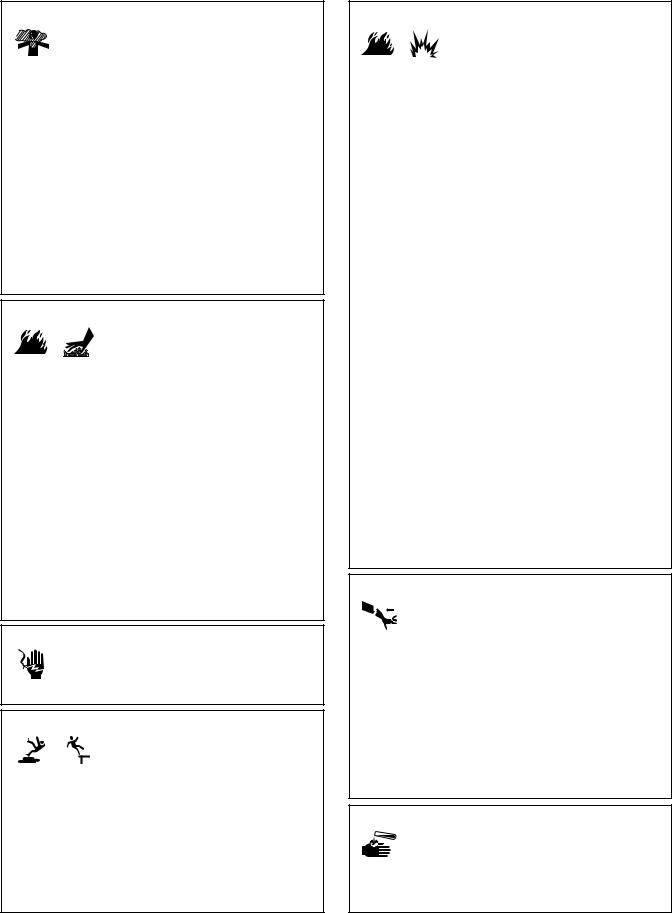
 WARNING Running engine gives off carbon
WARNING Running engine gives off carbon
monoxide, an odorless, colorless, poison gas.
Breathing carbon monoxide could result in death, serious injury, headache, fatigue, dizziness,
vomiting, confusion, seizures, nausea or fainting.
Some chemicals or detergents could be harmful if inhaled or ingested, resulting in death, serious injury, nausea, fainting or poisoning.
•Operate this product ONLY outdoors.
•Keep exhaust gas from entering a confined area through windows, doors, ventilation intakes, or other openings.
•DO NOT operate this product inside any building, carport, porch, mobile equipment, marine applications, or enclosure, even if windows and doors are open.
•Use a respirator or mask whenever there is a chance that vapors may be inhaled when using chemicals.
•Read all instructions with mask so you are certain the mask will provide the necessary protection against inhaling harmful vapors when using chemicals.
 WARNING Exhaust heat/gases could ignite combustibles, structures or damage fuel
WARNING Exhaust heat/gases could ignite combustibles, structures or damage fuel
tank causing a fire, resulting in death, serious injury and/or property damage.
Contact with muffler area could cause burns resulting in serious injury.
•DO NOT touch hot parts and AVOID hot exhaust gases.
•Allow equipment to cool before touching.
•Keep at least 5 feet (1.5 m) of clearance on all sides of pressure washer including overhead.
•It is a violation of California Public Resource Code, Section 4442, to use or operate the engine on any forest-covered, brush-covered, or grass-covered land unless the exhaust system is equipped with a spark arrester, as defined in Section 4442, maintained in effective working order. Other states or federal jurisdictions may have similar laws.
Contact the original equipment manufacturer, retailer, or dealer to obtain a spark arrester designed for the exhaust system installed on this engine.
•Replacement parts must be the same and installed in the same position as the original parts.
 WARNING Risk of electrocution.
WARNING Risk of electrocution.
Contact with power source could cause electric shock or burn resulting in death or serious injury.
• NEVER spray near power source.
 WARNING Use of pressure washer could create
WARNING Use of pressure washer could create
puddles and slippery surfaces causing you to fall resulting in death or serious
injury.
Kickback from spray gun could cause you to fall resulting in death or serious injury.
•Operate pressure washer from a stable surface.
•The cleaning area should have adequate slopes and drainage to reduce the possibility of a fall due to slippery surfaces.
•Be extremely careful if you must use the pressure washer from a ladder, scaffolding, or any other similar location.
•Firmly grasp spray gun with both hands when using high pressure spray to avoid injury when spray gun kicks back.
 WARNING Fuel and its vapors are extremely flammable and explosive which could cause burns,
WARNING Fuel and its vapors are extremely flammable and explosive which could cause burns,
fire or explosion resulting in death, serious injury and/or property damage.
WHEN ADDING OR DRAINING FUEL
•Turn pressure washer engine OFF and let it cool at least 2 minutes before removing fuel cap. Loosen cap slowly to relieve pressure in tank.
•Fill or drain fuel tank outdoors.
•DO NOT overfill tank. Allow space for fuel expansion.
•If fuel spills, wait until it evaporates before starting engine.
•Keep fuel away from sparks, open flames, pilot lights, heat, and other ignition sources.
•Check fuel lines, tank, cap and fittings frequently for cracks or leaks. Replace if necessary.
•DO NOT light a cigarette or smoke.
WHEN STARTING EQUIPMENT
•Ensure spark plug, muffler, fuel cap, and air cleaner are in place.
•DO NOT crank engine with spark plug removed.
WHEN OPERATING EQUIPMENT
•DO NOT operate this product inside any building, carport, porch, mobile equipment, marine applications, or enclosure.
•DO NOT tip engine or equipment at angle which causes fuel to spill.
•DO NOT spray flammable liquids.
WHEN TRANSPORTING, MOVING OR REPAIRING EQUIPMENT
•Transport/move/repair with fuel tank EMPTY or with fuel shutoff valve OFF.
•DO NOT tip engine or equipment at angle which causes fuel to spill.
•Disconnect spark plug wire.
WHEN STORING FUEL OR EQUIPMENT WITH FUEL IN TANK
•Store away from furnaces, stoves, water heaters, clothes dryers, or other appliances that have pilot light or other ignition source because they could ignite fuel vapors.
 WARNING Starter cord kickback (rapid retraction) will pull hand and arm toward engine faster than you
WARNING Starter cord kickback (rapid retraction) will pull hand and arm toward engine faster than you
can let go which could cause broken bones, fractures, bruises, or sprains resulting in serious
injury.
•NEVER pull starter cord without first relieving spray gun pressure.
•When starting engine, pull cord slowly until resistance is felt and then pull rapidly to avoid kickback.
•After each starting attempt, where engine fails to run, always point spray gun in safe direction, press red button and squeeze spray gun trigger to release high pressure.
•Firmly grasp spray gun with both hands when using high pressure spray to avoid injury when spray gun kicks back.
 WARNING Chemical Burn Hazard.
WARNING Chemical Burn Hazard.
Chemicals could cause burns resulting in death, serious injury, and/or property damage.
•DO NOT use caustic liquid with pressure washer.
•Use ONLY pressure washer safe detergents/soaps. Follow all manufacturers instructions.
5
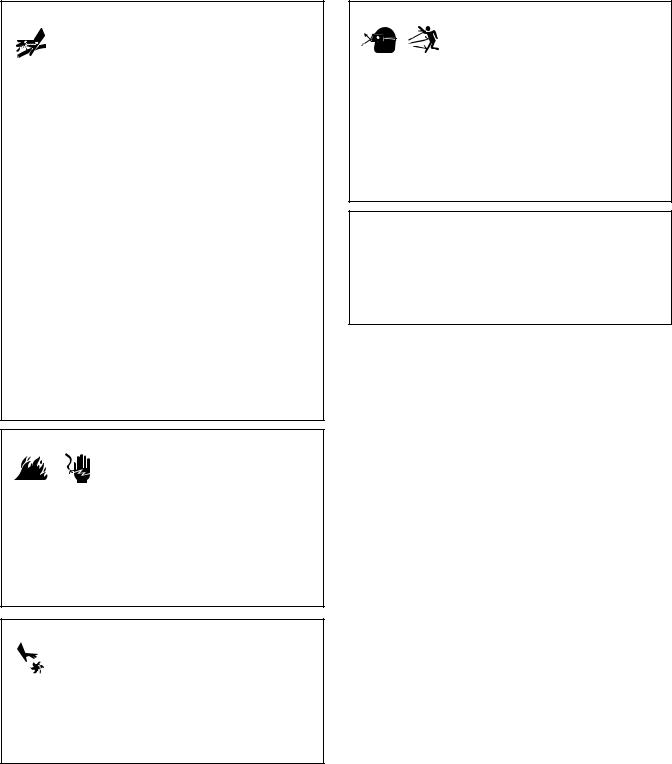
 WARNING The high pressure stream of water that this equipment produces could cut through skin
WARNING The high pressure stream of water that this equipment produces could cut through skin
and its underlying tissues, resulting in serious
injury and possible amputation.
Spray gun traps high water pressure, even when engine is stopped and water is disconnected, which could result in serious injury.
•If cut by fluid, call physician immediately. DO NOT treat as a simple cut.
•DO NOT allow CHILDREN to operate pressure washer.
•NEVER repair high pressure hose. Replace it.
•NEVER repair leaking connections with sealant of any kind. Replace o-ring or seal.
•NEVER connect high pressure hose to nozzle extension.
•Keep high pressure hose connected to pump and spray gun while system is pressurized.
•ALWAYS point spray gun in safe direction, press red button and squeeze spray gun trigger to release high pressure, every time you stop engine.
•NEVER aim spray gun at people, animals, or plants.
•DO NOT secure spray gun in open position.
•DO NOT leave spray gun unattended while machine is running.
•NEVER use a spray gun which does not have a trigger lock or trigger guard in place and in working order.
•Always be certain spray gun, nozzles and accessories are correctly attached.
 WARNING Unintentional sparking could cause fire or
WARNING Unintentional sparking could cause fire or
electric shock resulting in death or serious injury.
WHEN ADJUSTING OR MAKING REPAIRS TO YOUR PRESSURE WASHER
•Disconnect the spark plug wire from the spark plug and place the wire where it cannot contact spark plug.
WHEN TESTING FOR ENGINE SPARK
•Use approved spark plug tester.
•DO NOT check for spark with spark plug removed.
 WARNING Starter and other rotating parts could entangle hands, hair, clothing, or accessories
WARNING Starter and other rotating parts could entangle hands, hair, clothing, or accessories  resulting in serious injury.
resulting in serious injury.
•NEVER operate pressure washer without protective housing or covers.
•DO NOT wear loose clothing, jewelry or anything that could be caught in the starter or other rotating parts.
•Tie up long hair and remove jewelry.
 WARNING Risk of eye or bodily injury.
WARNING Risk of eye or bodily injury.
Spray could splash back or propel objects resulting in serious injury.
•Always wear indirect vented (chemical splash) safety goggles marked to comply with ANSI Z87.1 when using or in vicinity of this equipment.
•NEVER substitute safety glasses or dry-condition goggles for indirect vented safety goggles.
•Always wear protective clothing such as a long-sleeved shirt, long pants and close-toed shoes.
•NEVER operate pressure washer when barefoot or wearing sandals or shorts.
 CAUTION Excessively high operating speeds could result in minor injury and/or pressure washer damage. Excessively low speeds impose a heavy load.
CAUTION Excessively high operating speeds could result in minor injury and/or pressure washer damage. Excessively low speeds impose a heavy load.
•DO NOT tamper with governor spring, links or other parts to increase engine speed. Pressure washer supplies correct rated pressure and flow when running at governed speed.
•DO NOT modify pressure washer in any way.
NOTICE High pressure spray could damage fragile items including glass.
•DO NOT point spray gun at glass when using red (0°) spray tip.
•NEVER aim spray gun at plants.
NOTICE Improper treatment of pressure washer could damage it and shorten its life.
•If you have questions about intended use, ask dealer or contact qualified service center.
•NEVER operate units with broken or missing parts, or without protective housing or covers.
•DO NOT by-pass any safety device on this machine.
•DO NOT tamper with governed speed.
•DO NOT operate pressure washer above rated pressure.
•DO NOT modify pressure washer in any way.
•Before starting pressure washer in cold weather, check all parts of the equipment to be sure ice has not formed there.
•NEVER move machine by pulling on hoses. Use handle provided on unit.
•This equipment is designed to be used with Briggs & Stratton Power Products authorized parts ONLY. If equipment is used with parts that DO NOT comply with minimum specifications, user assumes all risks and liabilities.
6 |
www.troybilt.com |

Assembly
Read entire operator’s manual before you attempt to assemble or operate your new pressure washer.
Your pressure washer requires some assembly and is ready for use after it has been properly serviced with the recommended oil and fuel.
If you have any problems with the assembly of your pressure washer, please call the pressure washer helpline at
(888) 611-6708. If calling for assistance, please have the model, revision, and serial number from the identification label available.
Unpack Pressure Washer
1.Remove the parts bag, accessories, and inserts included with pressure washer.
2.Open carton completely by cutting each corner from top to bottom.
3.Ensure you have all included items prior to assembly.
Items in the carton include:
•Main Unit
•Handle
•High Pressure Hose
•Spray Gun
•Nozzle Extension with Quick Connect Fitting
•Plastic Accessory Tray
•Oil Bottle
•Parts Bag (which includes the following):
•Operator’s Manual
•Owner’s Registration Card
•Bag of 3 Multi–Colored Spray Tips
•Handle/Accessory Tray Fastening Hardware Kit (which includes):
•Carriage Bolts (2)
•Plastic Knobs (2)
•Tree Clips (4)
To prepare your pressure washer for operation, you will need to perform these tasks:
1.Fill out and send in registration card.
2.Attach handle and accessory tray to main unit.
3.Add oil to engine crankcase.
4.Add fuel to fuel tank.
5.Connect high pressure hose to spray gun and pump.
6.Connect water supply to pump.
7.Attach nozzle extension to spray gun.
8.Select/attach quick connect spray tip to nozzle extension.
Attach Handle and Accessory Tray
1.Place handle (A) onto handle supports connected to main unit. Make sure holes in handle align with holes on handle supports.
A |
B |
C |
2.Insert handle carriage bolts (B) through holes from inside of unit and attach a plastic knob (C) from outside of unit. Tighten by hand.
NOTICE By loosening both knobs to the middle section of the attachment bolt, the upper handle can fold forward to store flat atop the cold engine. DO NOT fold the handle down while the engine is hot.
3.Place accessory tray (D) over holes (E) on handle (viewing from front of unit). Push the tree clips (F) into the holes until they sit flat against the accessory tray.
E |
D |
F |
4.Insert multi–colored spray tips and other supplied accessories in spaces provided in accessory tray. See
How to Use Accessory Tray.
7

Add Engine Oil and Fuel
• Place pressure washer on a level surface.
NOTICE Any attempt to crank or start the engine before it has been properly filled with the recommended oil will result in equipment failure.
•Refer to engine manual for oil and fuel fill information.
•Damage to equipment resulting from failure to follow this instruction will void warranty.
•Refer to engine operator’s manual and follow oil and fuel recommendations and instructions.
NOTICE Check oil often during engine break–in. Refer to engine operator’s manual for recommendations.
Lubricate O-Rings
Lubrication of o-rings is extremely important for installation and operation. The use of a lubricant (petroleum or synthetic grease) during assembly helps seat o-rings properly and provides an improved seal. It also helps protect the o-ring from damage by abrasion, pinching or cutting and extends the life of the o-ring.
NOTICE ALWAYS apply a small amount of lubricant on o-rings prior to assembling the garden hose to the pump (A), high pressure hose (B), spray gun (C), and nozzle
extension (D).
Lubricate all connections shown below, following these instructions:
1.Inspect and clean connecting surfaces prior to lubrication and assembly.
2.Use lubricants sparingly during assembly; a light film is all that is required.
3. Use a small brush or cotton swab to apply grease directly to o-rings where they are not accessible (QC fitting, M22 fitting).
C |
D |
B |
A |
8 |
www.troybilt.com |

Connect Hose and Water Supply to Pump
NOTICE DO NOT run the pump without the water supply connected and turned on.
•Damage to equipment resulting from failure to follow this instruction will void warranty.
NOTICE Remove and discard the shipping caps from the pump’s high pressure outlet and water inlet before attaching hoses.
1.Uncoil high pressure hose and attach one end of hose to base of spray gun. Tighten by hand.
 WARNING The high pressure stream of water that this equipment produces could cut through skin
WARNING The high pressure stream of water that this equipment produces could cut through skin
and its underlying tissues, resulting in serious injury and possible amputation.
•NEVER connect high pressure hose to nozzle extension.
•Keep high pressure hose connected to pump and spray gun while system is pressurized.
•Always be certain spray gun, nozzles and accessories are correctly attached.
2.Attach other end of high pressure hose to high pressure outlet on pump. Tighten by hand.
3.Before connecting garden hose to water inlet, inspect inlet screen (A). Clean screen if it contains debris or have it replaced if damaged. DO NOT run pressure washer if inlet screen is damaged.
A
4.Run water through your garden hose for 30 seconds to clean out any debris.
NOTICE DO NOT siphon standing water for the water supply. Use ONLY cold water (less than 100°F).
NOTICE Using a One Way Valve (vacuum breaker or check valve) at pump inlet could cause pump or inlet connector damage.
•There MUST be at least ten feet of unrestricted garden hose between the pressure washer inlet and any device, such as a vacuum breaker or check valve.
•Damage to equipment resulting from failure to follow this instruction will void warranty.
5.Connect the garden hose (not to exceed 50 feet in length) to the water inlet. Tighten by hand.
 WARNING Risk of eye injury.
WARNING Risk of eye injury.
Spray could splash back or propel objects resulting in serious injury.
•Always wear indirect vented (chemical splash) safety goggles marked to comply with ANSI Z87.1 when using or in vicinity of this equipment.
•NEVER substitute safety glasses or dry-condition goggles for indirect vented safety goggles.
6.Turn ON the water, press red button (B) on the gun and squeeze the trigger to purge the pump system of air and impurities.
B
Checklist Before Starting Engine
Review the unit’s assembly to ensure you have performed all of the following.
1.Be sure to read the Operator Safety section and How to Use Your Pressure Washer in Operation section before using pressure washer.
2.Make sure handle is in place and secure.
3.Check that oil has been added to proper level in the engine crankcase.
4.Add proper fuel to fuel tank.
5.Check for properly tightened hose connections.
6.Check to make sure there are no kinks, cuts, or damage to high pressure hose.
7.Provide a proper water supply at an adequate flow.
9
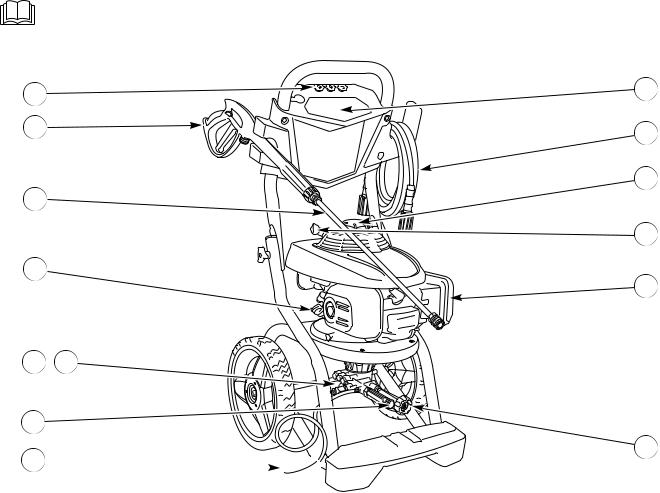
Features and Controls
Read this Operator’s Manual and safety rules before operating your pressure washer.
Compare the illustrations with your pressure washer, to familiarize yourself with the locations of various controls and adjustments. Save this manual for future reference.
A |
R |
|
|
B |
P |
|
|
|
N |
C |
|
|
M |
D |
|
|
K |
E , F
G






 J H
J H 

A - Spray Tips — Detergent, 0° and 25°: for various high pressure cleaning applications.
B - Spray Gun — Controls the application of water onto cleaning surface with trigger device. Includes trigger lock.
C - Nozzle Extension with Quick Connect — Allows you to switch between three different spray tips.
D - Oil Fill/Dipstick — Check and add engine oil here.
E - Pump — Develops high pressure.
F - Automatic Cool Down System — Cycles water through pump when water reaches 125°-155°F (51°-68°C). Warm water will discharge from pump onto ground. This system prevents internal pump damage.
G - High Pressure Outlet — Connection for high pressure hose.
H - Detergent Siphoning Tube — Use to siphon pressure washer safe detergents into the low pressure stream.
J - Water Inlet — Connection for garden hose.
K - Air Filter — Protects engine by filtering dust and debris out of intake air.
M - Recoil Starter — Used for starting the engine manually.
N - Fuel Tank — Fill tank with regular unleaded fuel. Always leave room for fuel expansion.
P - High Pressure Hose — Connect one end to water pump and the other end to spray gun.
R - Accessory Tray — Provides convenient storage for standard and optional accessories, such as brushes, turbo wands, etc.
Items Not Shown:
Identification Label (near rear of base plate) — Provides model and serial number of pressure washer. Please have these readily available if calling for assistance.
Warning/Operating Instructions Tag — Identifies hazards and proper procedure to start/stop pressure washer.
10 |
www.troybilt.com |
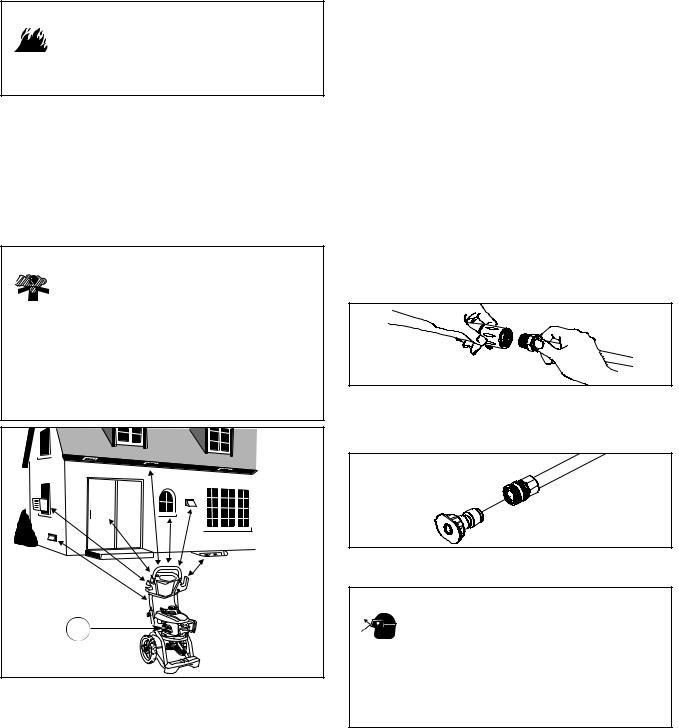
Operation
If you have any problems operating your pressure washer, please call the pressure washer helpline at (888) 611-6708.
Pressure Washer Location
Clearances and Air Movement
 WARNING Exhaust heat/gases could ignite
WARNING Exhaust heat/gases could ignite
combustibles, structures or damage fuel tank causing a fire, resulting in death, serious injury and/or property damage.
•Keep at least 5 ft. (1.5 m) clearance on all sides of pressure washer including overhead.
Place pressure washer outdoors in an area that will not accumulate deadly exhaust gas. DO NOT place pressure washer where exhaust gas could accumulate and enter inside or be drawn into a potentially occupied building. Ensure exhaust gas (A) is kept away from any windows, doors, ventilation intakes, or other openings that can allow exhaust gas to collect in a confined area. Prevailing winds and air currents should be taken into consideration when positioning pressure washer.
 WARNING Running engine gives off carbon
WARNING Running engine gives off carbon
monoxide, an odorless, colorless, poison gas.
Breathing carbon monoxide could result in death, serious injury, headache, fatigue, dizziness,
vomiting, confusion, seizures, nausea or fainting.
•Operate this product ONLY outdoors.
•Keep exhaust gas from entering a confined area through windows, doors, ventilation intakes, or other openings.
•DO NOT operate this product inside any building, carport, porch, mobile equipment, marine applications, or enclosure, even if windows and doors are open.
A |
How to Start Your Pressure Washer
To start your pressure washer for the first time, follow these instructions step-by-step. This starting information also applies if you have let the pressure washer sit idle for at least
aday.
1.Place pressure washer near an outside water source capable of supplying water at a flow rate greater than 3.3 gallons (12.5 l) per minute and no less than 20 PSI (1.38 BARS) at pressure washer end of garden hose. DO NOT siphon supply water.
2.Check that high pressure hose is tightly connected to spray gun and pump. See Assembly section.
3.Make sure unit is in a level position.
4.Connect garden hose to water inlet on pressure washer pump.
NOTICE DO NOT run the pump without the water supply connected and turned on.
•Damage to equipment resulting from failure to follow this instruction will void warranty.
5.Turn ON the water, press red button on spray gun and squeeze the trigger to purge the pump system of air and impurities.
6.Attach nozzle extension to spray gun. Tighten by hand.
7.Choose spray tip you want to use, pull back on collar of nozzle extension, insert spray tip and release collar. Tug on spray tip to make sure it is securely in place. See
How to Use Spray Tips.
NOTICE Before starting the pressure washer, be sure you are wearing safety goggles as described below.
 WARNING Risk of eye injury.
WARNING Risk of eye injury.
Spray could splash back or propel objects resulting in serious injury.
•Always wear indirect vented (chemical splash) safety goggles marked to comply with ANSI Z87.1 when using or in vicinity of this equipment.
•NEVER substitute safety glasses or dry-condition goggles for indirect vented safety goggles.
11
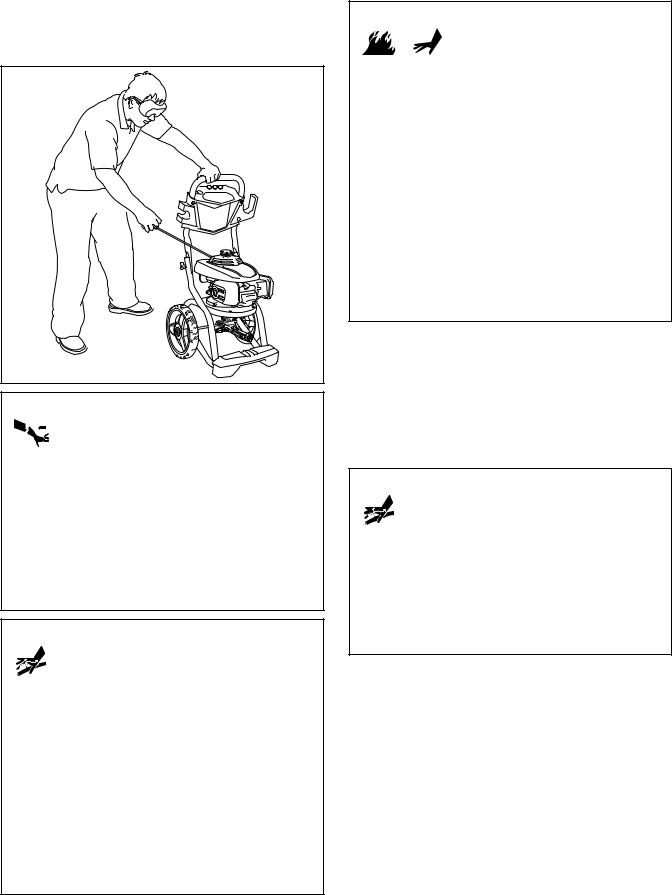
8.When starting engine, position yourself as recommended and start engine according to instructions given in engine operator’s manual. Also see operating instructions tag located on the pressure washer.
 WARNING Starter cord kickback (rapid retraction) will pull hand and arm toward engine faster than you
WARNING Starter cord kickback (rapid retraction) will pull hand and arm toward engine faster than you
can let go which could cause broken bones, fractures, bruises, or sprains resulting in serious
injury.
•NEVER pull starter cord without first relieving spray gun pressure.
•When starting engine, pull cord slowly until resistance is felt and then pull rapidly to avoid kickback.
•After each starting attempt, where engine fails to run, always point spray gun in safe direction, press red button and squeeze spray gun trigger to release high pressure.
•Firmly grasp spray gun with both hands when using high pressure spray to avoid injury when spray gun kicks back.
 WARNING The high pressure stream of water that this equipment produces could cut through skin
WARNING The high pressure stream of water that this equipment produces could cut through skin
and its underlying tissues, resulting in serious
injury and possible amputation.
Spray gun traps high water pressure, even when engine is stopped and water is disconnected, which could result in serious injury.
•DO NOT allow CHILDREN to operate pressure washer.
•Keep high pressure hose connected to pump and spray gun while system is pressurized.
•NEVER aim spray gun at people, animals, or plants.
•DO NOT secure spray gun in open position.
•DO NOT leave spray gun unattended while machine is running.
•NEVER use a spray gun which does not have a trigger lock or trigger guard in place and in working order.
•Always be certain spray gun, nozzles and accessories are correctly attached.
 WARNING Exhaust heat/gases could ignite combustibles, structures or damage fuel
WARNING Exhaust heat/gases could ignite combustibles, structures or damage fuel  tank causing a fire, resulting in death,
tank causing a fire, resulting in death,  serious injury and/or property damage.
serious injury and/or property damage.
Contact with muffler area could cause burns resulting in serious injury.
•DO NOT touch hot parts and AVOID hot exhaust gases.
•Allow equipment to cool before touching.
•Keep at least 5 feet (1.5 m) of clearance on all sides of pressure washer including overhead.
•It is a violation of California Public Resource Code, Section 4442, to use or operate the engine on any forest-covered, brush-covered, or grass-covered land unless the exhaust system is equipped with a spark arrester, as defined in Section 4442, maintained in effective working order. Other states or federal jurisdictions may have similar laws.
Contact the original equipment manufacturer, retailer, or dealer to obtain a spark arrester designed for the exhaust system installed on this engine.
•Replacement parts must be the same and installed in the same position as the original parts.
How to Stop Your Pressure Washer
1.Release spray gun trigger and let engine idle for two minutes.
2.Turn engine off according to instructions given in engine operator’s manual.
3.ALWAYS point gun in a safe direction, press red button and squeeze spray gun trigger to release retained high water pressure.
 WARNING The high pressure stream of water that this equipment produces could cut through skin
WARNING The high pressure stream of water that this equipment produces could cut through skin
and its underlying tissues, resulting in serious
injury and possible amputation.
Spray gun traps high water pressure, even when engine is stopped and water is disconnected, which could result in serious injury.
•Keep high pressure hose connected to pump and spray gun while system is pressurized.
•ALWAYS point spray gun in safe direction, press red button and squeeze spray gun trigger to release high pressure, every time you stop engine.
12 |
www.troybilt.com |
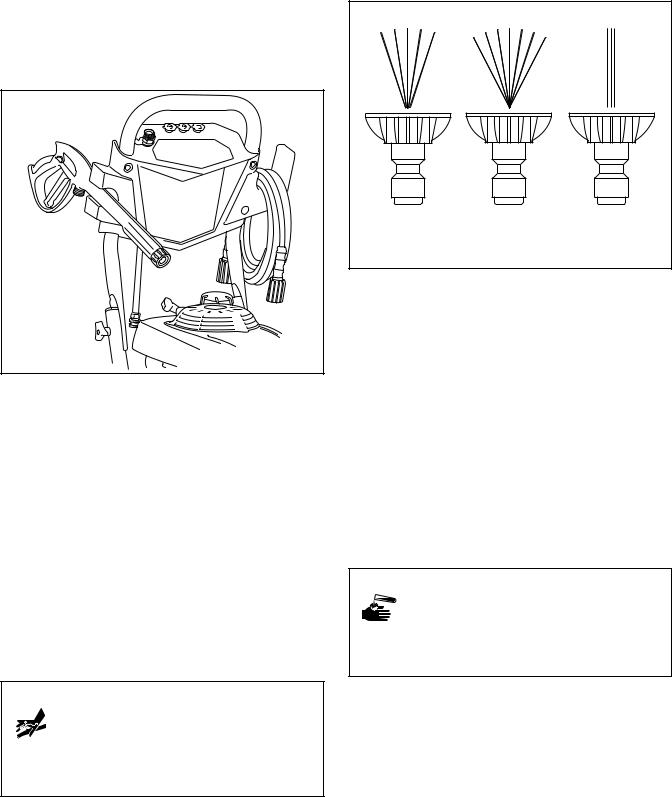
How to Use Accessory Tray
The unit is equipped with an accessory tray with places to store your spray gun, nozzle extension, high pressure hose and quick connect spray tips.
1.Place spray gun through notches on left side of accessory tray as shown.
2.Place nozzle extension in hole on left side of accessory tray as shown.
3.Insert multi–colored spray tips in spaces provided in accessory tray.
4.Hang high pressure hose on hook attached to the right side of the accessory tray as shown.
How to Use Spray Tips
The quick–connect on the nozzle extension allows you to switch between three different quick connect spray tips. Spray tips can be changed while pressure washer is running once spray gun trigger is locked. The spray tips vary the spray pattern as shown.
Follow these instructions to change spray tips:
1.Pull back collar on quick–connect and pull current spray tip off. Store spray tips in holder provided on the accessory tray.
 WARNING The high pressure stream of water that this equipment produces could cut through skin
WARNING The high pressure stream of water that this equipment produces could cut through skin
and its underlying tissues, resulting in serious injury and possible amputation.
•NEVER exchange spray tips without the trigger lock being engaged on the spray gun.
•DO NOT twist spray tips while spraying.
2. Select desired spray tip:
Low Pressure |
High Pressure |
|
Black |
25° Green |
0° Red |
Use to apply |
|
|
detergent |
|
|
•For gentle rinse, select green 25° spray tip.
•To scour surface, select red 0° spray tip.
•To apply detergent, select black spray tip.
3.Pull back on collar, insert new spray tip and release collar. Tug on spray tip to make sure it is securely in place.
Usage Tips
•For most effective cleaning, keep spray tip from 8 to 24 inches (20 to 61 cm) away from cleaning surface.
•If you get spray tip too close, especially using a high pressure spray tip, you may damage surface being cleaned.
•DO NOT get closer than 6 inches (15 cm) when cleaning tires.
Applying Detergent
 WARNING Chemical Burn Hazard.
WARNING Chemical Burn Hazard.
Chemicals could cause burns resulting in death, serious injury, and/or property damage.
•DO NOT use caustic liquid with pressure washer.
•Use ONLY pressure washer safe detergents/soaps. Follow all manufacturers instructions.
To apply detergent, follow these steps:
1.Review use of spray tips.
2.Prepare detergent solution as required by job.
3.Place detergent siphoning tube into detergent container.
NOTICE Make sure tube is fully submerged in detergent while applying detergent.
NOTICE Contact with hot muffler could damage detergent siphoning tube.
•When inserting siphon into a detergent solution bottle, route tube to keep it from inadvertently contacting the hot muffler.
13
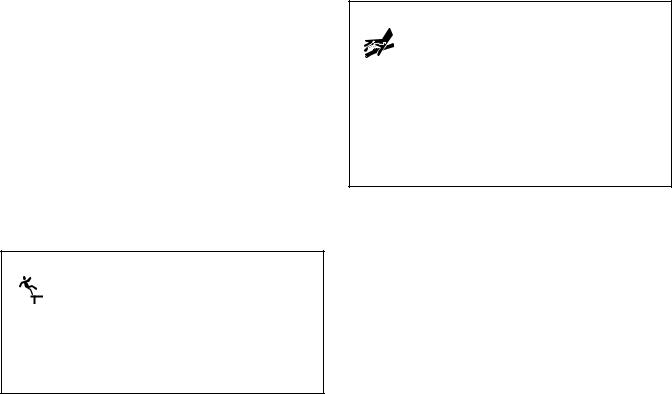
4. Make sure black spray tip is installed.
NOTICE Detergent cannot be applied with the high pressure spray tips (Green or Red).
5.Make sure garden hose is connected to water inlet. Check that high pressure hose is connected to spray gun and pump. Turn on water.
NOTICE You must attach all hoses before you start the engine.
•Starting the engine without all the hoses connected and without the water turned ON could damage the pump.
•Damage to equipment resulting from failure to follow this instruction will void warranty.
6.Start engine following instructions How to Start Your Pressure Washer.
7.Apply detergent to a dry surface, starting at lower portion of area to be washed and work upward, using long, even, overlapping strokes.
8.Allow detergent to "soak in" for 3-5 minutes before washing and rinsing. Reapply as needed to prevent surface from drying. DO NOT allow detergent to dry on (prevents streaking).
NOTICE You must flush the detergent siphoning system after each use by placing the tube into a bucket of clean water, then run the pressure washer in low pressure for 1-2 minutes.
Pressure Washer Rinsing
For Rinsing:
1.Remove black spray tip from nozzle extension.
2.Select and install desired high pressure spray tip following instructions How to Use Spray Tips.
3.Keep spray gun a safe distance from area you plan to spray.
 WARNING Kickback from spray gun could cause you to fall resulting in death or serious injury.
WARNING Kickback from spray gun could cause you to fall resulting in death or serious injury.
•Operate pressure washer from a stable surface.
•Be extremely careful if you must use the pressure washer from a ladder, scaffolding, or any other similar location.
•Firmly grasp spray gun with both hands when using high pressure spray to avoid injury when spray gun kicks back.
4.Apply a high pressure spray to a small area and then check surface for damage. If no damage is found, you can assume it is okay to continue rinsing.
5.Start at top of area to be rinsed, working down with same overlapping strokes as you used for cleaning.
Cleaning Detergent Siphoning Tube
If you used the detergent siphoning tube, you must flush it with clean water before stopping the engine.
1.Place detergent siphoning tube in a bucket full of clean water.
2.Remove high pressure spray tip from nozzle extension.
3.Select and install black detergent spray tip following instructions How to Use Spray Tips.
4.Flush for 1-2 minutes.
5.Shut off engine following instructions How to Stop Pressure Washer and turn off water supply.
6.ALWAYS point spray gun in a safe direction, press red button and squeeze spray gun trigger to release retained high water pressure.
 WARNING The high pressure stream of water that this equipment produces could cut through skin
WARNING The high pressure stream of water that this equipment produces could cut through skin
and its underlying tissues, resulting in serious
injury and possible amputation.
Spray gun traps high water pressure, even when engine is stopped and water is disconnected, which could result in serious injury.
•Keep high pressure hose connected to pump and spray gun while system is pressurized.
•ALWAYS point spray gun in safe direction, press red button and squeeze spray gun trigger to release high pressure, every time you stop engine.
Automatic Cool Down System (Thermal Relief)
If you run the engine on your pressure washer for
3-5 minutes without pressing the trigger on the spray gun, circulating water in the pump can reach temperatures above 125°F (51°C). The system engages to cool the pump by discharging the warm water onto the ground.
14 |
www.troybilt.com |
